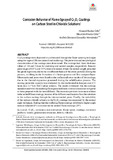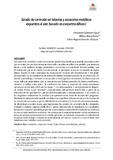Mostrar el registro sencillo del ítem
Corrosion Behavior of Flame Sprayed Cr2O3 Coatings on Carbon Steel in Chloride Solutions
Comportamiento corrosivo de recubrimientos de Cr2O3 rociados térmicamente sobre acero al carbono en soluciones de cloruro
| dc.contributor.author | Núñez Celis, Howard | |
| dc.contributor.author | Rincón Ortiz, Mauricio | |
| dc.contributor.author | González Hernández, Andrés Giovanni | |
| dc.date.accessioned | 2023-11-28T18:29:32Z | |
| dc.date.available | 2023-11-28T18:29:32Z | |
| dc.date.created | 2022-03-31 | |
| dc.identifier.issn | 1692-3324 | |
| dc.identifier.uri | http://hdl.handle.net/11407/8216 | |
| dc.description | Cr2O3 coatings were deposited on carbon steel through the flame spraying technique using two types of flames (neutral and oxidizing). The protective and morphological characteristics of the coatings were determined. The coatings had layer thickness values of 114 and 214μm for oxidizing and neutral samples, respectively. Porosity percentages of 4.5 % and 2.5 % were determined, where the neutral sample presented the greatest porosity due to the insufficient fusion of the oxide particles during the process, resulting in the formation of a heterogeneous and less compact layer. Microcracks and pores were found on the surface and cross-section of the coatings, due to the thermal expansion generated during the solidification process. The coating protective capacity was evaluated by electrochemical techniques over 672 hours in a 3.5 %wt NaCl saline solution. The results evidenced that the coatings manufactured with the oxidizing flame presented more corrosion resistance compared to those prepared with the neutral flame. The corrosion products were more evidente in the neutral flame coatings, because of the diffusion mechanisms from the substrate to the surface coating through the interconnected pores. Finally, the wettability of the sodium chloride solution in the Cr2O3 coatings was measured by the contact angle technique, finding that the oxidizing flame coatings exhibited a higher angle contact value (64.8°) in contrast to the neutral flame coatings (35°). | eng |
| dc.description | Los recubrimientos de Cr2O3 fueron depositados en un acero al carbono a través de la técnica de rociado térmico, usando dos tipos de llamas (neutra y oxidante). Se determinaron las características protectoras y morfológicas de los recubrimientos. Los recubrimientos mostraron espesores de capa con valores de 114 y 214 μm para las muestras depositadas con llamas neutra y oxidante, respectivamente. Se determinaron los porcentajes de porosidad de 4,5 y 2,5 %, en donde la muestra que se depositó con la llama neutra presentó la mayor porosidad debido a una fusión insuficiente de las partículas de óxido durante el proceso, resultando en la formación de una capa menos compacta y heterogénea. Las microgrietas y los poros se encontraron en la superficie y en la sección trasversal de los revestimientos debido a la expansión térmica generada durante el proceso de solidificación. La capacidad protectora de los recubrimientos fue evaluada a partir de técnicas electroquímicas por 672 horas en una solución salina 3,5 %wt NaCl. Los resultados evidenciaron que los revestimientos elaborados con la llama oxidante presentaron una mayor resistencia a la corrosión en comparación con aquellos elaborados con la llama neutra. Los productos de corrosión fueron más evidentes en los recubrimientos con llama neutra debido a los mecanismos de difusión desde el sustrato a la superficie recubierta a través de los poros interconectados. Finalmente, la humectabilidad de la solución de cloruro de sodio en los recubrimientos de Cr2O3 fueron medidos por medio de la técnica de ángulo de contacto, encontrando que los revestimientos de llama oxidante mostraron un mayor ángulo de contacto (64,8 °) en contraste con los recubrimientos de llama neutra (35 °). | spa |
| dc.format | ||
| dc.format.extent | p. 143-162 | |
| dc.format.medium | Electrónico | |
| dc.format.mimetype | application/pdf | |
| dc.language.iso | eng | |
| dc.publisher | Universidad de Medellín | |
| dc.relation.ispartofseries | Revista Ingenierías Universidad de Medellín; Vol. 21 No. 40 (2022) | |
| dc.relation.haspart | Revista Ingenierías Universidad de Medellín; Vol. 21 Núm. 40 enero-junio 2022 | |
| dc.relation.uri | https://revistas.udem.edu.co/index.php/ingenierias/article/view/3836 | |
| dc.rights.uri | http://creativecommons.org/licenses/by-nc-nd/4.0/ | * |
| dc.rights.uri | http://creativecommons.org/licenses/by-nc-nd/4.0 | * |
| dc.source | Revista Ingenierías Universidad de Medellín; Vol. 21 No. 40 (2022): (enero-junio); 143-162 | |
| dc.subject | Cr2O3 | eng |
| dc.subject | Corrosion | eng |
| dc.subject | Microstructure | eng |
| dc.subject | Flame spray | eng |
| dc.subject | Coatings | eng |
| dc.subject | Corrosión products | eng |
| dc.subject | Kinetic | eng |
| dc.subject | Polarization resistance | eng |
| dc.subject | Defects | eng |
| dc.subject | Chloride | eng |
| dc.subject | Cr2O3 | spa |
| dc.subject | Corrosión | spa |
| dc.subject | Microestructura | spa |
| dc.subject | Rociado térmico | spa |
| dc.subject | Recubrimientos | spa |
| dc.subject | Productos de corrosión | spa |
| dc.subject | Cinética | spa |
| dc.subject | Resistencia a la polarización | spa |
| dc.subject | Defectos | spa |
| dc.subject | Cloruro | spa |
| dc.title | Corrosion Behavior of Flame Sprayed Cr2O3 Coatings on Carbon Steel in Chloride Solutions | eng |
| dc.title | Comportamiento corrosivo de recubrimientos de Cr2O3 rociados térmicamente sobre acero al carbono en soluciones de cloruro | spa |
| dc.type | article | |
| dc.identifier.doi | https://doi.org/10.22395/rium.v21n40a9 | |
| dc.relation.citationvolume | 21 | |
| dc.relation.citationissue | 40 | |
| dc.relation.citationstartpage | 143 | |
| dc.relation.citationendpage | 162 | |
| dc.audience | Comunidad Universidad de Medellín | |
| dc.publisher.faculty | Facultad de Ingenierías | |
| dc.coverage | Lat: 06 15 00 N degrees minutes Lat: 6.2500 decimal degreesLong: 075 36 00 W degrees minutes Long: -75.6000 decimal degrees | |
| dc.publisher.place | Medellín | |
| dc.relation.references | A. López-Ortega, J. L. Arana, E. Rodríguez, and R. Bayón, “Corrosion, wear and tribocorrosion performance of a thermally sprayed aluminum coating modified by plasma electrolytic oxidation technique for offshore submerged components protection,” Corros. Sci., vol. 143, pp. 258–280, Oct. 2018, doi: 10.1016/j.corsci.2018.08.001. | |
| dc.relation.references | D. Dwivedi, K. Lepková, and T. Becker, “Carbon steel corrosion: a review of key Surface properties and characterization methods,” RSC Adv., vol. 7, no. 8, pp. 4580–4610, 2017, doi: 10.1039/C6RA25094G. | |
| dc.relation.references | A. López-Ortega, R. Bayón, and J. L. Arana, “Evaluation of protective coatings for offshore applications. Corrosion and tribocorrosion behavior in synthetic seawater,” Surf. Coatings Technol., vol. 349, pp. 1083–1097, Sep. 2018, doi: 10.1016/j.surfcoat.2018.06.089. | |
| dc.relation.references | Y. Ma, Y. Li, and F. Wang, “Corrosion of low carbon steel in atmospheric environments of different chloride content,” Corros. Sci., vol. 51, no. 5, pp. 997–1006, May 2009, doi: 10.1016/j.corsci.2009.02.009. | |
| dc.relation.references | B. Syrek-Gerstenkorn, S. Paul, and A. J. Davenport, “Use of thermally sprayed aluminium (TSA) coatings to protect offshore structures in submerged and splash zones,” Surf. Coatings Technol., vol. 374, no. April, pp. 124–133, 2019, doi: 10.1016/j.surfcoat.2019.04.048. | |
| dc.relation.references | K. V. Sreenivas Rao, G. C. Tejaswini, and K. G. Girisha, “Corrosion Behavior of Plasma Sprayed Cr2O3 - Al2O3 - ZrO2 Multilayer Coatings on Mild Steel,” 2018, doi: 10.1016/j.matpr.2018.10.200. | |
| dc.relation.references | A. V. Pinzón, K. J. Urrego, A. González-Hernández, M. Rincón Ortiz, and F. Vargas Galvis,“Corrosion protection of carbon steel by alumina-titania ceramic coatings used for industrial applications,” Ceram. Int., vol. 44, no. 17, 2018, doi: 10.1016/j.ceramint.2018.08.273. | |
| dc.relation.references | Z. Liu, Y. Dong, Z. Chu, Y. Yang, Y. Li, and D. Yan, “Corrosion behavior of plasma sprayed ceramic and metallic coatings on carbon steel in simulated seawater,” Mater. Des., vol. 52, no. 29, pp. 630–637, 2013, doi: 10.1016/j.matdes.2013.06.002. | |
| dc.relation.references | A. S. Hamdy, D. P. Butt, and A. A. Ismail, “Electrochemical impedance studies of sol-gel based ceramic coatings systems in 3.5% NaCl solution,” Electrochim. Acta, vol. 52, no. 9, pp. 3310–3316, 2007, doi: 10.1016/j.electacta.2006.10.036. | |
| dc.relation.references | X. Huang, S. Sun, and G. Tu, “Investigation of mechanical properties and oxidation resistance of CVD TiB2 ceramic coating on molybdenum,” J. Mater. Res. Technol., vol. 9, no. 1, pp. 282–290, 2020, doi: 10.1016/j.jmrt.2019.10.056. | |
| dc.relation.references | J. Lawal, P. Kiryukhantsev-Korneev, A. Matthews, and A. Leyland, “Mechanical properties and abrasive wear behaviour of Al-based PVD amorphous/nanostructured coatings,” Surf. Coatings Technol., vol. 310, pp. 59–69, 2017, doi: 10.1016/j.surfcoat.2016.12.031. | |
| dc.relation.references | P. L. Fauchais, J. V. R. Heberlein, and M. I. Boulos, Thermal spray fundamentals: From powder to part. 2014. | |
| dc.relation.references | V. R. S. Sá Brito, I. N. Bastos, and H. R. M. Costa, “Corrosion resistance and characterization of metallic coatings deposited by thermal spray on carbon steel,” Mater. Des., vol. 41, pp. 282–288, Oct. 2012, doi: 10.1016/j.matdes.2012.05.008. | |
| dc.relation.references | P. Zamani and Z. Valefi, “Microstructure, phase composition and mechanical properties of plasma sprayed Al2O3, Cr2O3 and Cr2O3-Al2O3 composite coatings,” Surf. Coatings Technol., vol. 316, pp. 138–145, 2017, doi: 10.1016/j.surfcoat.2017.03.022. | |
| dc.relation.references | A. M. Oje, A. A. Ogwu, S. U. Rahman, A. I. Oje, and N. Tsendzughul, “Effect of temperatura variation on the corrosion behaviour and semiconducting properties of the passive film formed on chromium oxide coatings exposed to saline solution,” Corros. Sci., vol. 154, no. April, pp. 28–35, 2019, doi: 10.1016/j.corsci.2019.04.004. | |
| dc.relation.references | P. S. Babu, D. Sen, A. Jyothirmayi, L. R. Krishna, and D. S. Rao, “Influence of microstructure on the wear and corrosion behavior of detonation sprayed Cr2O3-Al2O3 and plasma sprayed Cr2O3 coatings,” Ceram. Int., vol. 44, no. 2, pp. 2351–2357, 2018, doi: 10.1016/j.ceramint.2017.10.203. | |
| dc.relation.references | F. Fanicchia, D. A. Axinte, J. Kell, R. McIntyre, G. Brewster, and A. D. Norton, “Combustion Flame Spray of CoNiCrAlY & YSZ coatings,” Surf. Coatings Technol., vol. 315, pp. 546–557, 2017, doi: 10.1016/j.surfcoat.2017.01.070. | |
| dc.relation.references | A. Förg, M. Blum, A. Killinger, J. A. Moreno Nicolás, and R. Gadow, “Deposition of chromium oxide-chromium carbide coatings via high velocity suspension flame spraying (HVSFS),” Surf. Coatings Technol., vol. 351, no. July, pp. 171–176, 2018, doi: 10.1016/j. surfcoat.2018.07.072. | |
| dc.relation.references | X. B. Liang, J. C. Shang, Y. X. Chen, Z. D. Zhou, Z. B. Zhang, and B. S. Xu, “Influence of ceramic particles and process parameters on residual stress of flame-sprayed Fe-based coatings,” Surf. Coatings Technol., vol. 354, no. August, pp. 10–17, 2018, doi: 10.1016/j. surfcoat.2018.08.069. | |
| dc.relation.references | R. Rachidi, B. El Kihel, and F. Delaunois, “Microstructure and mechanical characterization of NiCrBSi alloy and NiCrBSi-WC composite coatings produced by flame spraying,” Mater. Sci. Eng. B Solid-State Mater. Adv. Technol., vol. 241, no. November 2017, pp. 13–21, 2019, doi: 10.1016/j.mseb.2019.02.002. | |
| dc.relation.references | ASTM International, “ASTM E2109−01: Test Methods of Determining Area Percentage Porosity in Thermal Sprayed Coatings,” Stand. Test Methods Determ. Area Percent. Porosity Therm. Sprayed Coatings, vol. 01, no. Reapproved 2014, pp. 1–8, 2014, doi: 10.1520/E2109-01R14.2. | |
| dc.relation.references | ASTM G 106, “Standard Practice for Verification of Algorithm and Equipment for Electrochemical Impedance Measurements,” Astm, vol. 03, no. Reapproved, pp. 1–11, 1999, doi: 10.1520/G0106-89R10.2. | |
| dc.relation.references | S. K. Sriramoju, Rashmi, A. Suresh, and P. S. Dash, “Generation of low ash fine clean coal powder by autogenous grinding process powder technology,” Powder Technol., vol. 342, pp. 67–72, 2019, doi: 10.1016/j.powtec.2018.09.079. | |
| dc.relation.references | N. H. N. Yusoff, M. J. Ghazali, M. C. Isa, A. R. Daud, and A. Muchtar, “Effects of poder size and metallic bonding layer on corrosion behaviour of plasma-sprayed Al2O3-13% TiO2 coated mild steel in fresh tropical seawater,” Ceram. Int., vol. 39, no. 3, pp. 2527–2533, 2013, doi: 10.1016/j.ceramint.2012.09.012. | |
| dc.relation.references | E. C. Iglesias, C. P. Velásquez, and F. V. Galvis, “Estudio de llamas oxiacetilénicas usadas en la proyección térmica,” no. 9, pp. 15–26, 2016. | |
| dc.relation.references | E. E. Balić, M. Hadad, P. P. Bandyopadhyay, and J. Michler, “Fundamentals of adhesion of thermal spray coatings: Adhesion of single splats,” Acta Mater., vol. 57, no. 19, pp. 5921–5926, 2009, doi: 10.1016/j.actamat.2009.08.042. | |
| dc.relation.references | F. Vargas, H. Ageorges, P. Fauchais, M. E. López, and J. A. Calderon, “Permeation of saline solution in Al2O3-13wt.% TiO2 coatings elaborated by atmospheric plasma spraying,” Surf. Coatings Technol., vol. 220, pp. 85–89, 2013, doi: 10.1016/j.surfcoat.2012.11.038. | |
| dc.relation.references | S. K. Singh, S. P. Tambe, G. Gunasekaran, V. S. Raja, and D. Kumar, “Electrochemical impedance study of thermally sprayable polyethylene coatings,” Corros. Sci., vol. 51, no. 3, pp. 595–601, 2009, doi: 10.1016/j.corsci.2008.11.025. | |
| dc.relation.references | S. L. De Assis, S. Wolynec, and I. Costa, “Corrosion characterization of titanium alloys by electrochemical techniques,” Electrochim. Acta, vol. 51, no. 8–9, pp. 1815–1819, 2006, doi: 10.1016/j.electacta.2005.02.121. | |
| dc.relation.references | V. F. ILvovich, Impedance spectroscopy: Applications to Electrochemical and Dielectric Phenomena. New Jerdey: Wiley, 2012. | |
| dc.relation.references | A. K. Basak, J. P. Celis, P. Ponthiaux, F. Wenger, M. Vardavoulias, and P. Matteazzi, “Effect of nanostructuring and Al alloying on corrosion behaviour of thermal sprayed WC-Co coatings,” Mater. Sci. Eng. A, vol. 558, pp. 377–385, 2012, doi: 10.1016/j.msea.2012.08.015. | |
| dc.relation.references | F. Shao, K. Yang, H. Zhao, C. Liu, L. Wang, and S. Tao, “Effects of inorganic sealant and brief heat treatments on corrosion behavior of plasma sprayed Cr2O3-Al2O3 composite ceramic coatings,” Surf. Coatings Technol., vol. 276, pp. 8–15, 2015, doi: 10.1016/j.surfcoat.2015.06.045. | |
| dc.relation.references | C. Haixiang and K. Dejun, “Comparison on electrochemical corrosion performances of arcand laser thermal sprayed Al–Ti–Ni coatings in marine environment,” Mater. Chem. Phys., vol. 251, no. January, p. 123200, 2020, doi: 10.1016/j.matchemphys.2020.123200. | |
| dc.relation.references | E. McCafferty, Introduction to corrosion science, Springer. Alexandria VA: Springer, 2010. | |
| dc.relation.references | Y. Zuo, R. Pang, W. Li, J. P. Xiong, and Y. M. Tang, “The evaluation of coating performance by the variations of phase angles in middle and high frequency domains of EIS,” Corros. Sci., vol. 50, no. 12, pp. 3322–3328, 2008, doi: 10.1016/j.corsci.2008.08.049. | |
| dc.relation.references | H. S. Lee, J. K. Singh, and J. H. Park, “Pore blocking characteristics of corrosion products formed on Aluminum coating produced by arc thermal metal spray process in 3.5wt.% NaCl solution,” Constr. Build. Mater., vol. 113, pp. 905–916, 2016, doi: 10.1016/j.conbuildmat.2016.03.135. | |
| dc.relation.references | Z. Bergant, U. Trdan, and J. Grum, “Effect of high-temperature furnace treatment on the microstructure and corrosion behavior of NiCrBSi flame-sprayed coatings,” Corros. Sci., vol. 88, pp. 372–386, 2014, doi: 10.1016/j.corsci.2014.07.057. | |
| dc.relation.references | M. Stern and A. . Geary, “Electrochemical polarization; I. Polarization curves,” J. Electrochem., vol. 104, pp. 56–63, 1957. | |
| dc.relation.references | S. . Dean, W. . France, and S. . Ketcham, “Electrochemical Methods” Hanbook on Corrosion Testing and Evaluation. New York: John Wiley, 1971. | |
| dc.relation.references | ASTM G102-89, “Standard Practice for Calculation of Corrosion Rates and Related information from Electrochemical Measurements,” ASTM, pp. 1–7, 2015. | |
| dc.relation.references | X. Wang, B. Lv, Z. Hu, and B. Xu, “Corrosion resistance in sodium chloride solution of Ni-Co-P electro-brush amorphous coatings to replace hard chromium coatings,” Phys. Procedia, vol. 50, no. October 2012, pp. 191–198, 2013, doi: 10.1016/j.phpro.2013.11.031. | |
| dc.relation.references | T. S. Hamidon and M. H. Hussin, “Susceptibility of hybrid sol-gel (TEOS-APTES) doped withcaffeine as potent corrosion protective coatings for mild steel in 3.5 wt.% NaCl,” Prog. Org. Coatings, vol. 140, no. November 2019, p. 105478, 2020, doi: 10.1016/j.porgcoat.2019.105478. | |
| dc.relation.references | Y. M. Liu, Z. Q. Wu, and D. C. Yin, “Measurement of contact angle under different gravity generated by a long-arm centrifuge,” Colloids Surfaces A Physicochem. Eng. Asp., vol. 588, no. December 2019, p. 124381, 2020, doi: 10.1016/j.colsurfa.2019.124381. | |
| dc.relation.references | N. Karthik, S. Asha, and M. G. Sethuraman, “Influence of pH-sensitive 4-aminothiophenol on the copper corrosion inhibition of hybrid sol–gel monolayers,” J. Sol-Gel Sci. Technol., vol. 78, no. 2, pp. 248–257, 2016, doi: 10.1007/s10971-015-3944-5. | |
| dc.rights.creativecommons | Attribution-NonCommercial-NoDerivatives 4.0 International | * |
| dc.identifier.eissn | 2248-4094 | |
| dc.type.coar | http://purl.org/coar/resource_type/c_6501 | |
| dc.type.version | info:eu-repo/semantics/publishedVersion | |
| dc.type.local | Artículo científico | |
| dc.type.driver | info:eu-repo/semantics/article | |
| dc.identifier.reponame | reponame:Repositorio Institucional Universidad de Medellín | |
| dc.identifier.repourl | repourl:https://repository.udem.edu.co/ | |
| dc.identifier.instname | instname:Universidad de Medellín |




